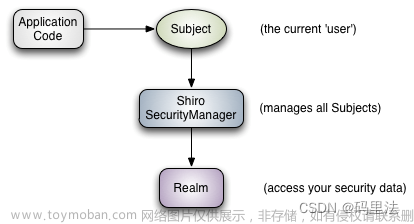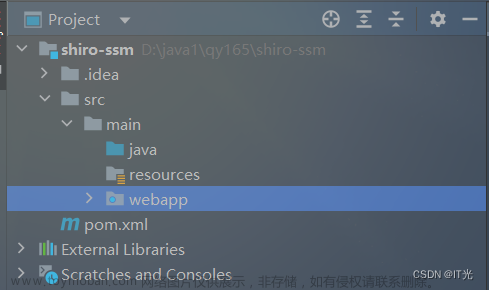序言
前面我们学习了如下内容:
5 分钟入门 shiro 安全框架实战笔记
shiro 整合 spring 实战及源码详解
相信大家对于 shiro 已经有了最基本的认识,这一节我们一起来学习写如何将 shiro 与 spring 进行整合。
spring 整合
maven 依赖
<dependencies>
<dependency>
<groupId>org.apache.shiro</groupId>
<artifactId>shiro-spring</artifactId>
<version>1.7.0</version>
</dependency>
<dependency>
<groupId>org.springframework</groupId>
<artifactId>spring-context</artifactId>
<version>4.3.13.RELEASE</version>
</dependency>
</dependencies>
服务类定义
定义一个简单的服务类,用于演示 @RequiresPermissions 注解的权限校验。
package com.github.houbb.shiro.inaction02.springalone;
import org.apache.shiro.authz.annotation.RequiresPermissions;
import org.slf4j.Logger;
import org.slf4j.LoggerFactory;
import org.springframework.stereotype.Component;
/**
* Simple Service with methods protected with annotations.
*/
@Component
public class SimpleService {
private static Logger log = LoggerFactory.getLogger(SimpleService.class);
@RequiresPermissions("write")
public void writeRestrictedCall() {
log.info("executing method that requires the 'write' permission");
}
@RequiresPermissions("read")
public void readRestrictedCall() {
log.info("executing method that requires the 'read' permission");
}
}
快速开始
我们对原来的 Quick Start 进行改造如下:
package com.github.houbb.shiro.inaction02.springalone;
import org.apache.shiro.SecurityUtils;
import org.apache.shiro.authc.UsernamePasswordToken;
import org.apache.shiro.authz.AuthorizationException;
import org.apache.shiro.mgt.SecurityManager;
import org.apache.shiro.subject.Subject;
import org.slf4j.Logger;
import org.slf4j.LoggerFactory;
import org.springframework.beans.factory.annotation.Autowired;
import org.springframework.stereotype.Component;
import javax.annotation.PostConstruct;
/**
* Simple Bean used to demonstrate subject usage.
*/
@Component
public class QuickStart {
private static Logger log = LoggerFactory.getLogger(QuickStart.class);
@Autowired
private SecurityManager securityManager;
@Autowired
private SimpleService simpleService;
/**
* Sets the static instance of SecurityManager. This is NOT needed for web applications.
*/
@PostConstruct
private void initStaticSecurityManager() {
SecurityUtils.setSecurityManager(securityManager);
}
public void run() {
// get the current subject
Subject subject = SecurityUtils.getSubject();
// Subject is not authenticated yet
System.out.println(!subject.isAuthenticated());
// login the subject with a username / password
UsernamePasswordToken token = new UsernamePasswordToken("joe.coder", "password");
subject.login(token);
// joe.coder has the "user" role
subject.checkRole("user");
// joe.coder does NOT have the admin role
System.out.println(!subject.hasRole("admin"));
// joe.coder has the "read" permission
subject.checkPermission("read");
// current user is allowed to execute this method.
simpleService.readRestrictedCall();
try {
// but not this one!
simpleService.writeRestrictedCall();
}
catch (AuthorizationException e) {
log.info("Subject was NOT allowed to execute method 'writeRestrictedCall'");
}
// logout
subject.logout();
System.out.println(!subject.isAuthenticated());
}
}
这里最核心的区别是 SecurityManager 是直接通过 @Autowired 注入得到的。
也没有看到我们以前初始化 SecurityManager 的 ini 文件,这些在下面的配置文件中。
配置类
package com.github.houbb.shiro.inaction02.springalone;
import org.apache.shiro.realm.Realm;
import org.apache.shiro.realm.text.TextConfigurationRealm;
import org.apache.shiro.spring.config.ShiroAnnotationProcessorConfiguration;
import org.apache.shiro.spring.config.ShiroBeanConfiguration;
import org.apache.shiro.spring.config.ShiroConfiguration;
import org.springframework.context.annotation.*;
/**
* Application bean definitions.
*/
@Configuration
@Import({ShiroBeanConfiguration.class,
ShiroConfiguration.class,
ShiroAnnotationProcessorConfiguration.class})
@ComponentScan("com.github.houbb.shiro.inaction02.springalone")
public class CliApp {
/**
* Example hard coded Realm bean.
* @return hard coded Realm bean
*/
@Bean
public Realm realm() {
TextConfigurationRealm realm = new TextConfigurationRealm();
realm.setUserDefinitions("joe.coder=password,user\n" +
"jill.coder=password,admin");
realm.setRoleDefinitions("admin=read,write\n" +
"user=read");
realm.setCachingEnabled(true);
return realm;
}
}
这里通过 @Bean 的方式声明了用户角色等信息,可以简单理解为和 Ini 文件初始化是等价的。
@Import 导入了 3 个配置类,我们后面进行介绍。
启动
spring 应用的启动:
public static void main(String[] args) {
AnnotationConfigApplicationContext context = new AnnotationConfigApplicationContext(CliApp.class);
context.getBean(QuickStart.class).run();
}
测试日志如下:
十二月 31, 2020 10:33:02 上午 org.springframework.context.annotation.AnnotationConfigApplicationContext prepareRefresh
信息: Refreshing org.springframework.context.annotation.AnnotationConfigApplicationContext@6267c3bb: startup date [Thu Dec 31 10:33:02 CST 2020]; root of context hierarchy
十二月 31, 2020 10:33:03 上午 org.springframework.context.support.PostProcessorRegistrationDelegate$BeanPostProcessorChecker postProcessAfterInitialization
信息: Bean 'org.apache.shiro.spring.config.ShiroBeanConfiguration' of type [org.apache.shiro.spring.config.ShiroBeanConfiguration$$EnhancerBySpringCGLIB$$fbe016b3] is not eligible for getting processed by all BeanPostProcessors (for example: not eligible for auto-proxying)
...
信息: Bean 'org.apache.shiro.spring.config.ShiroAnnotationProcessorConfiguration' of type [org.apache.shiro.spring.config.ShiroAnnotationProcessorConfiguration$$EnhancerBySpringCGLIB$$f9d46e86] is not eligible for getting processed by all BeanPostProcessors (for example: not eligible for auto-proxying)
十二月 31, 2020 10:33:03 上午 org.springframework.context.support.PostProcessorRegistrationDelegate$BeanPostProcessorChecker postProcessAfterInitialization
信息: Bean 'eventBus' of type [org.apache.shiro.event.support.DefaultEventBus] is not eligible for getting processed by all BeanPostProcessors (for example: not eligible for auto-proxying)
十二月 31, 2020 10:33:03 上午 org.springframework.context.support.PostProcessorRegistrationDelegate$BeanPostProcessorChecker postProcessAfterInitialization
信息: Bean 'org.apache.shiro.spring.config.ShiroConfiguration' of type [org.apache.shiro.spring.config.ShiroConfiguration$$EnhancerBySpringCGLIB$$3db21503] is not eligible for getting processed by all BeanPostProcessors (for example: not eligible for auto-proxying)
...
true
true
true
ShiroBeanConfiguration 配置类
@Import 共计导入了 3 个配置类,我们接下来逐一分析下这 3 个配置类。
源码
@Configuration
public class ShiroBeanConfiguration extends AbstractShiroBeanConfiguration {
@Bean
@Override
public LifecycleBeanPostProcessor lifecycleBeanPostProcessor() {
return super.lifecycleBeanPostProcessor();
}
@Bean
@Override
protected EventBus eventBus() {
return super.eventBus();
}
@Bean
@Override
public ShiroEventBusBeanPostProcessor shiroEventBusAwareBeanPostProcessor() {
return super.shiroEventBusAwareBeanPostProcessor();
}
}
这 3 个方法都是继承自父类,直接调用的父类方法。
- AbstractShiroBeanConfiguration.java
public class AbstractShiroBeanConfiguration {
protected LifecycleBeanPostProcessor lifecycleBeanPostProcessor() {
return new LifecycleBeanPostProcessor();
}
protected EventBus eventBus() {
return new DefaultEventBus();
}
protected ShiroEventBusBeanPostProcessor shiroEventBusAwareBeanPostProcessor() {
return new ShiroEventBusBeanPostProcessor(eventBus());
}
}
实际上这里初始化了 3 个对象:LifecycleBeanPostProcessor/DefaultEventBus/ShiroEventBusBeanPostProcessor。
LifecycleBeanPostProcessor
这个类实际上比较简单,主要做了 2 件事情。
(1)执行 init() 和 destory()。
(2)指定对应的优先级,默认为最低。
核心部分如下:
- init 初始化
public Object postProcessBeforeInitialization(Object object, String name) throws BeansException {
if (object instanceof Initializable) {
try {
if (log.isDebugEnabled()) {
log.debug("Initializing bean [" + name + "]...");
}
((Initializable) object).init();
} catch (Exception e) {
throw new FatalBeanException("Error initializing bean [" + name + "]", e);
}
}
return object;
}
- destory 销毁
public void postProcessBeforeDestruction(Object object, String name) throws BeansException {
if (object instanceof Destroyable) {
try {
if (log.isDebugEnabled()) {
log.debug("Destroying bean [" + name + "]...");
}
((Destroyable) object).destroy();
} catch (Exception e) {
throw new FatalBeanException("Error destroying bean [" + name + "]", e);
}
}
}
DefaultEventBus
这个类如其名,就是默认的事件总线类。
接口的如下:
public interface EventBus {
void publish(Object var1);
void register(Object var1);
void unregister(Object var1);
}
分别对应的是事件的发布,注册和取消注册。
实现部分实际就是调用对应的 EventListener 类,并且通过读写锁保证并发安全,暂时不做展开。
ShiroEventBusBeanPostProcessor
这个类实际上是配合 EventBus 使用的,核心实现如下:
public class ShiroEventBusBeanPostProcessor implements BeanPostProcessor {
final private EventBus eventBus;
public ShiroEventBusBeanPostProcessor(EventBus eventBus) {
this.eventBus = eventBus;
}
@Override
public Object postProcessAfterInitialization(Object bean, String beanName) throws BeansException {
//1. 如果实现了 EventBusAware 接口
if (bean instanceof EventBusAware) {
((EventBusAware) bean).setEventBus(eventBus);
}
//2. 如果有 Subscribe 注解信息
else if (isEventSubscriber(bean)) {
eventBus.register(bean);
}
return bean;
}
}
这里会把实现了 EventBusAware 接口,和指定了 @Subscribe 注解的对象,注解对应的 eventbus。
ShiroConfiguration 配置
思考
我们 QuickStart 中自动注入了 SecurityManager 对象,这个对象是在哪里初始化的呢?
核心源码
核心部分如下:
@Configuration
@Import({ShiroBeanConfiguration.class})
public class ShiroConfiguration extends AbstractShiroConfiguration {
@Bean
@Override
protected SessionsSecurityManager securityManager(List<Realm> realms) {
return super.securityManager(realms);
}
@Bean
@Override
protected SessionManager sessionManager() {
return super.sessionManager();
}
//... 省略其他组件
}
这里可以发现实际上已经导入了 ShiroBeanConfiguration 配置类,所以官方的 demo 可以简化如下:
@Configuration
@Import({ShiroConfiguration.class,
ShiroAnnotationProcessorConfiguration.class})
@ComponentScan("com.github.houbb.shiro.inaction02.springalone")
public class CliApp{}
实际测试了一下,也是通过的。
SecurityManager 初始化
我简单的看了下 SecurityManager 实现子类还是比较多得。断点可以发现默认的类型是 DefaultSecurityManager。
这些都可以在 AbstractShiroConfiguration 类中找到答案。
- AbstractShiroConfiguration.java
核心实现如下:
public class AbstractShiroConfiguration {
@Autowired
protected EventBus eventBus;
protected SessionsSecurityManager securityManager(List<Realm> realms) {
SessionsSecurityManager securityManager = createSecurityManager();
securityManager.setEventBus(eventBus);
// 省略其他属性设置
return securityManager;
}
protected SessionsSecurityManager createSecurityManager() {
DefaultSecurityManager securityManager = new DefaultSecurityManager();
securityManager.setSubjectDAO(subjectDAO());
securityManager.setSubjectFactory(subjectFactory());
RememberMeManager rememberMeManager = rememberMeManager();
if (rememberMeManager != null) {
securityManager.setRememberMeManager(rememberMeManager);
}
return securityManager;
}
}
securityManager(List<Realm> realms) 方法会把我们 CliApp 中定义的 Realm 对象当作参数传入。
createSecurityManager() 方法就会初始化 DefaultSecurityManager 对象。
ShiroAnnotationProcessorConfiguration 配置
思考
我们在 SampleService 中使用了注解 @RequiresPermissions("write"),就可以校验对应的权限了。
但是这一切是如何被自动实现的呢?
源码
@Configuration
public class ShiroAnnotationProcessorConfiguration extends AbstractShiroAnnotationProcessorConfiguration{
@Bean
@DependsOn("lifecycleBeanPostProcessor")
protected DefaultAdvisorAutoProxyCreator defaultAdvisorAutoProxyCreator() {
return super.defaultAdvisorAutoProxyCreator();
}
@Bean
protected AuthorizationAttributeSourceAdvisor authorizationAttributeSourceAdvisor(SecurityManager securityManager) {
return super.authorizationAttributeSourceAdvisor(securityManager);
}
}
本身没有什么源码,主要看下父类。
AbstractShiroAnnotationProcessorConfiguration
public class AbstractShiroAnnotationProcessorConfiguration {
protected DefaultAdvisorAutoProxyCreator defaultAdvisorAutoProxyCreator() {
return new DefaultAdvisorAutoProxyCreator();
}
protected AuthorizationAttributeSourceAdvisor authorizationAttributeSourceAdvisor(SecurityManager securityManager) {
AuthorizationAttributeSourceAdvisor advisor = new AuthorizationAttributeSourceAdvisor();
advisor.setSecurityManager(securityManager);
return advisor;
}
}
DefaultAdvisorAutoProxyCreator 是 spring 中的自动代理实现类,此处不做展开。
我们重点看一下 AuthorizationAttributeSourceAdvisor 对象:
AuthorizationAttributeSourceAdvisor
这里主要做了两件事:
(1)设置对应的 securityManager
(2)处理有 RequiresPermissions 等 shiro 的内置注解的方法。
@SuppressWarnings({"unchecked"})
public class AuthorizationAttributeSourceAdvisor extends StaticMethodMatcherPointcutAdvisor {
private static final Logger log = LoggerFactory.getLogger(AuthorizationAttributeSourceAdvisor.class);
private static final Class<? extends Annotation>[] AUTHZ_ANNOTATION_CLASSES =
new Class[] {
RequiresPermissions.class, RequiresRoles.class,
RequiresUser.class, RequiresGuest.class, RequiresAuthentication.class
};
protected SecurityManager securityManager = null;
/**
* Create a new AuthorizationAttributeSourceAdvisor.
*/
public AuthorizationAttributeSourceAdvisor() {
setAdvice(new AopAllianceAnnotationsAuthorizingMethodInterceptor());
}
public SecurityManager getSecurityManager() {
return securityManager;
}
public void setSecurityManager(org.apache.shiro.mgt.SecurityManager securityManager) {
this.securityManager = securityManager;
}
}
AopAllianceAnnotationsAuthorizingMethodInterceptor
这个名字起的,好家伙,真长。
这里就是对于注解的响应方法 aop 拦截器实现。
package org.apache.shiro.spring.security.interceptor;
import org.aopalliance.intercept.MethodInterceptor;
import org.aopalliance.intercept.MethodInvocation;
import org.apache.shiro.aop.AnnotationResolver;
import org.apache.shiro.authz.aop.*;
import org.apache.shiro.spring.aop.SpringAnnotationResolver;
import java.lang.reflect.Method;
import java.util.ArrayList;
import java.util.List;
/**
* Allows Shiro Annotations to work in any <a href="http://aopalliance.sourceforge.net/">AOP Alliance</a>
* specific implementation environment (for example, Spring).
*
* @since 0.2
*/
public class AopAllianceAnnotationsAuthorizingMethodInterceptor
extends AnnotationsAuthorizingMethodInterceptor implements MethodInterceptor {
public AopAllianceAnnotationsAuthorizingMethodInterceptor() {
List<AuthorizingAnnotationMethodInterceptor> interceptors =
new ArrayList<AuthorizingAnnotationMethodInterceptor>(5);
//use a Spring-specific Annotation resolver - Spring's AnnotationUtils is nicer than the
//raw JDK resolution process.
AnnotationResolver resolver = new SpringAnnotationResolver();
//we can re-use the same resolver instance - it does not retain state:
interceptors.add(new RoleAnnotationMethodInterceptor(resolver));
interceptors.add(new PermissionAnnotationMethodInterceptor(resolver));
interceptors.add(new AuthenticatedAnnotationMethodInterceptor(resolver));
interceptors.add(new UserAnnotationMethodInterceptor(resolver));
interceptors.add(new GuestAnnotationMethodInterceptor(resolver));
setMethodInterceptors(interceptors);
}
//省略 invoke 部分
}
到这里实际上就比较简单了,相信聪明如你一定已经知道整个 spring-shiro 面纱背后的秘密了。
我们直接看一下 PermissionAnnotationMethodInterceptor 的实现。
PermissionAnnotationMethodInterceptor
import org.apache.shiro.aop.AnnotationResolver;
public class PermissionAnnotationMethodInterceptor extends AuthorizingAnnotationMethodInterceptor {
public PermissionAnnotationMethodInterceptor() {
super( new PermissionAnnotationHandler() );
}
/**
* @param resolver
* @since 1.1
*/
public PermissionAnnotationMethodInterceptor(AnnotationResolver resolver) {
super( new PermissionAnnotationHandler(), resolver);
}
}
处理类实现如下:
package org.apache.shiro.authz.aop;
import org.apache.shiro.authz.AuthorizationException;
import org.apache.shiro.authz.annotation.Logical;
import org.apache.shiro.authz.annotation.RequiresPermissions;
import org.apache.shiro.authz.annotation.RequiresRoles;
import org.apache.shiro.subject.Subject;
import java.lang.annotation.Annotation;
public class PermissionAnnotationHandler extends AuthorizingAnnotationHandler {
public PermissionAnnotationHandler() {
super(RequiresPermissions.class);
}
// 获取对应的注解值
protected String[] getAnnotationValue(Annotation a) {
RequiresPermissions rpAnnotation = (RequiresPermissions) a;
return rpAnnotation.value();
}
// 校验当前主题,是否拥有对应的权限。
public void assertAuthorized(Annotation a) throws AuthorizationException {
if (!(a instanceof RequiresPermissions)) return;
RequiresPermissions rpAnnotation = (RequiresPermissions) a;
String[] perms = getAnnotationValue(a);
Subject subject = getSubject();
if (perms.length == 1) {
subject.checkPermission(perms[0]);
return;
}
if (Logical.AND.equals(rpAnnotation.logical())) {
getSubject().checkPermissions(perms);
return;
}
if (Logical.OR.equals(rpAnnotation.logical())) {
// Avoid processing exceptions unnecessarily - "delay" throwing the exception by calling hasRole first
boolean hasAtLeastOnePermission = false;
for (String permission : perms) if (getSubject().isPermitted(permission)) hasAtLeastOnePermission = true;
// Cause the exception if none of the role match, note that the exception message will be a bit misleading
if (!hasAtLeastOnePermission) getSubject().checkPermission(perms[0]);
}
}
}
小结
这一节我们讲解了如何整合 spring 与 shiro,下一节我们将实战整合 springboot 与 shiro,感兴趣的小伙伴可以关注一波不迷路。
为了便于大家学习,所有源码都已开源:
https://gitee.com/houbinbin/shiro-inaction/tree/master/shiro-inaction-02-springalone
希望本文对你有所帮助,如果喜欢,欢迎点赞收藏转发一波。
我是老马,期待与你的下次相遇。
参考资料
10 Minute Tutorial on Apache Shiro
https://shiro.apache.org/reference.html
https://shiro.apache.org/session-management.html文章来源:https://www.toymoban.com/news/detail-836765.html
本文由博客一文多发平台 OpenWrite 发布!文章来源地址https://www.toymoban.com/news/detail-836765.html
到了这里,关于shiro 整合 spring 实战及源码详解的文章就介绍完了。如果您还想了解更多内容,请在右上角搜索TOY模板网以前的文章或继续浏览下面的相关文章,希望大家以后多多支持TOY模板网!











